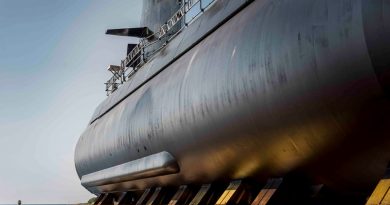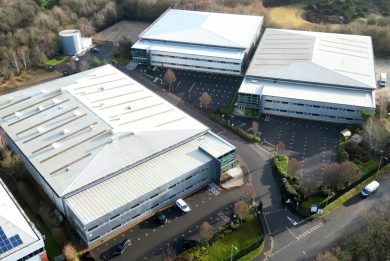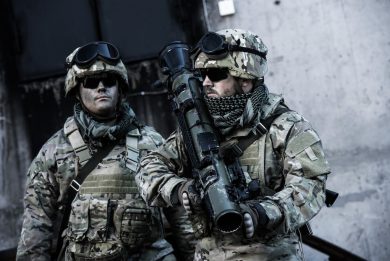Eurosatory 2024 – Saab Deployable Health Care: bringing medical support forward
Transition from asymmetric warfare operations to peer-to-peer confrontation does not affect only combat units, also field medical support must adapt itself to the new situation, and Saab response is the Deployable Health Care solution, DHC in short
At Eurosatory 2024 the Swedish company was exhibiting its Deployable Health Care (DHC) in Hall 5b, which was dedicated to capabilities and solutions developed to respond to the many and varied crises linked to conflicts or natural disasters.
What is clear is that casualties must be treated as soon as possible, to increase the probability to save them. In operations carried out for over 20 years by western forces, the key lifesaver was the helicopter that allowed to evacuate casualties to a full-fledged field hospital in less than one hour, the “Golden Hour” concept; in current conflicts the rotary wing CASEVAC/MEDEVAC intervention is not an option due to the presence of a suite of air defence assets. Hence the need to push forward medical capabilities as close as possible to the combat area. NATO has already shifted from the Golden Hour to the “10-1-2” scheme stated in the August 2018 edition of the AJMedP-2, which calls for first aid within ten minutes, advanced resuscitation within one hour and surgery within two hours of wounding.
“In both Mali, Afghanistan, etc. we had total air and land domination. We could have a Role 3 and as much equipment as we wanted. Now, as we learn from Ukraine, as soon as vehicles appear they attract enemy fire, which means when the patient transportation starts, we must regroup. This is why everybody is looking for smaller, more flexible, modular medical units. And this applies to all systems, even all the way up from the backpack to the Role 3 hospital,” Dr. Rickard Ånell, Saab’s Global Medical Adviser, MD, PhD and Flight surgeon, and former Swedish Special Forces flight surgeon, tells EDR On-Line.
Self-care or buddy-buddy care take place in the immediate aftermath of the incident, at the point of injury. “In tactical combat casualty care, or TCCC, it’s not the surgeon you meet, it’s not even the combat medic, it is the man next to you, the one that helps you out, the one who counts the most.” Training and individual medical kits are therefore key elements of the TCCC, Saab providing down to the first aid bandage.
Usually, combat medics are available at the casualty collection point; “This is the medics backpack that allows them treating the two most life-threatening issues, bleeding and airway,” Dr. Ånell says while showing us the actual backpacks that constitute the first line-item of Saab’s Deployable Health Care. This is fitted with a carrying system derived from the one used by Swedish Ranger units providing thus maximum comfort.
Within 10 minutes casualties should reach the Role 1 which provides life-saving capacity without surgery. For this Saab developed the Pre-Hospital Trauma concept, a system that can be easily carried and deployed within 10 minutes. Here medis can perform damage control resuscitation (DCR) thanks to the equipment contained in three backpacks weighing 30 kg each; one contains the tent, the second the medical resuscitation equipment and the third one medicines and bandages.
As no surgery capacity is available at the Role 1, patients who need higher-level cares must be moved to the next step of the medical chain, the Role 2F where F stands for forward. According to protocol, patients should reach it within one hour. The Role 2F is capable of Damage Control Surgery (DCS) and should be deployed as close as possible to the combat area. The surgical team is made of four people, two medics, one nurse and one surgeon, and moves into a pick-up vehicle. “As soon as we get out of the vehicle, we can start treating the patient, all the system being designed for four people and one pickup. While the surgeon and the nurse start treating the patient, the medics put on the tent to have a controlled and clean environment, the best option being rigging it inside a building,” Dr. Ånell explains.
As soon as the tent is ready, a matter of minutes, surgery can start; “Everything we need is contained in a box, so we take off the lid, put everything up, and we have all we need for the anaesthetics. This means that the nurse can start sedating the patient, and I can open it up, stop the bleeding and close him again, as at this stage the aim is to stop the life-threatening bleeding,” Dr. Ånell says. However, the surgery module is only one of the three that made up the Role 2F, the other two being the resuscitation module and the ward module. The latter was added as in peer-to-peer scenarios it might be impossible to immediately transport the casualty to a higher-level medical facility; this might be impeded by enemy actions, and for example you might have to wait for night cover to move casualties in a reduced risk condition. “What we added to the system now is the PCC, to prolonged casualty care, where we can take care of the patient for up to 72 hours. The system was designed to allow us to put litters on top of each other to spare room,” Dr. Ånell explains. Overall, the three modules have a mass of 700 kg. These are not necessarily deployed together. “When deployed, as a military doctor you are often asked to go in two or three different directions, so we made it dividable. We can take the resuscitation, put it closer to the point of injury, the surgery, and the ward a bit further back, where we can stabilise the patients and wait for a medevac,” he adds. Of course, modules can be added, as in a conventional scenario casualties can be an order of magnitude more that in asymmetric scenarios.
From the Role 2F the patients will reach a Role 2B (Basic), where primary surgery can be performed and patients can be kept on hold before sending them further back, to a Role 2E (Enhanced), for specialty surgery and critical care, and finally to a Role 3. The ideal MEDEVAC chain should bring the casualty to the Role 2B within two hours, and to the Role 2E within four hours, however the 72 hours capacity of the Role 2F shows that this should not be always possible.
Saab being a Swedish company, and Dr. Ånell having served with the Swedish Army, it is obvious that cold weather issues have been fully considered. Hypothermia represents one of the many dangers for casualties, so warming them up is a key issue. The first item is a rewarming blanket that has three layers, a reflecting one, an isolating one and a rewarming one, the latter being based on a chemical reaction that starts as soon as the blanket is removed from its packaging and gets in contact with the air, a system selected also for its low mass. A multifuel stove was selected, which can burn firewood, diesel, or other materiel, ensuring good temperature inside the tents, even with -35°C outside. It is to note that inflatable tents have low pressure bows, which make them easy to repair avoid them collapsing ifa compressor should fail or a bullet punch through a structural bow.
Blood availability is another key issue, but here national laws have an impact. “We all know how important it is to get blood as close to the point of injury as possible. Even the medics’ backpacks have both active and passive blood transportation systems. How we do this comes down to national law, which dictates some requirements,” the Saab medical advisor says. “When I was in Mali, we used dry frozen blood. It was dry, frozen blood, coming from the Netherlands; it contained glycerol so we had to wash the deep-frozen blood, but we could take it up whenever we need to,” he added. Beside the defrost aspect, before giving blood to the patient this just be warmed; “One of the most dangerous things you can do to a hypothermic patient is to give him cold fluids or blood, because the heart gets a wrong rhythm, and he can die. It is important that you give him warm fluids,” Dr. Ånell explains, “and in our package we have the latest version of the blood warmer. It can heat up to 39°C any fluid for 12 hours, and it is a real game changer.”
One of the methods for stopping blood loss is, when possible, to apply a tourniquet between the wound and the heart. The use of such device was forbidden for some time, however it is now allowed once again. “When you put on a tourniquet it, it forms a clot. When you release it, the clot is blown away and bleeding starts again. The clouting agent in the body is limited, so when releasing tourniquet, you should put on a haemostatic dressing. To do so you need education and training as if you leave the tourniquet for too long this can lead to serious troubles, and this is why we see an increase in amputations in Ukraine,” the former Swedish Army surgeon explains.
His experience has impacted the design of Saab’s DHC. In November 2021 Saab Australia and Philips Australia signed a contract for the delivery of innovative healthcare solutions as part of Australia’s deployable health capability (DHC) programme, Joint Program 2060 Phase 3 (JP2060Ph3). More than 550 health modules to provide clinical care, including surgery, advanced medical imaging, trauma, and intensive care services are being delivered to the Australian defence forces.
Before leaving Dr. Rickard Ånell, we asked him about the effect of the Swedish adhesion to NATO on the nation’s military medical system. “I would say it had a greater impact on the civilian medical community rather than to the military one, as we were already training very often with neighbouring Norway. During the Cold War our hospitals used to have a backup operation theatre in the underground. In the last 20 years several hospitals were built in glass, which means that should one bomb fall near to them they cannot operate anymore,” he explains. Saab’s DHC can provide that capability if a protected area is available. All NATO countries hospitals should have that capability. But this is another story.
Photos by P. Valpolini









